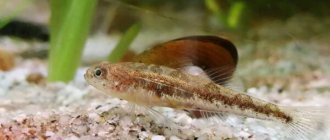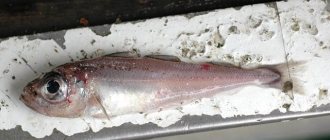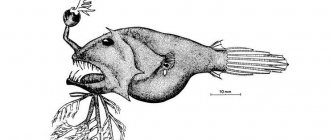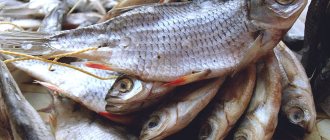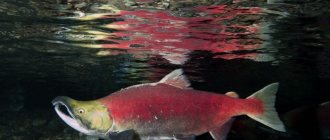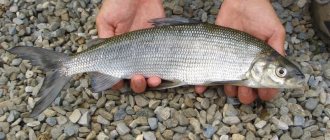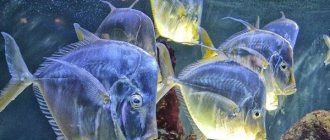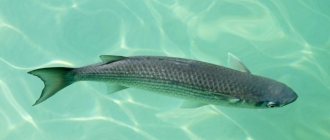The sea wolf or sea bass fish is a predatory representative of the Moronov family. Prefers to live in the salty waters of the coastal zone. The body is elongated and strong. The average size of an individual is 50-60 cm, although there are representatives up to a meter, with females slightly larger than males. The wolf got its nickname because of its death grip and powerful, mouth-like jaws with large fangs. In different countries, sea bass has its own name.
The sea wolf is a predatory fish that lives in the seas
Species of sea wolf
Wolf fish is divided into two species, each of which has external and behavioral characteristics:
- Common bay laurel. The body is elongated, the skeleton is strong with a small number of bones. The body is covered with large scales. There are a pair of fins on the back, while the front one is equipped with spikes. Lives in the eastern part of the Atlantic Ocean. The life expectancy of the predator is 15 years, although there are individuals that have reached 30 years of age.
- Chilean sea bass. Due to the dark color and aggressive behavior, a second name for the fish appeared - black sea bass. The scales covering the body change color depending on the body of water in which the sea wolf lives. Thus, the body of a predator can take on shades from brown to dark gray. The dorsal fins are pointed and used as a means of protection. Chilean sea bass, although similar to sea bass, is a different species and belongs to the Nototheniaceae family. Representatives cannot tolerate heat, so they prefer to sit out in the depths. Favorable water temperature for living is no more than 11 degrees. Individuals are found in the western part of the Atlantic Ocean and the Gulf of Mexico.
https://youtube.com/watch?v=krCMJzniYf0
What kind of fish is sea bass and where is it found?
Almost every good restaurant serves Chilean sea bass. Sea wolf has high prices, but it is valued for its unusual taste and juicy meat .
Common laurel is considered one of the species of ray-finned fish from the perciform family; they like to breed it for sale, and this reduces its cost.
Lavrak is a sea fish, not a river fish, and is divided into the following types:
- Ordinary.
- Black.
- Chilean.
The common laurel is found in the Atlantic Ocean, has a strong skeleton and many bones, this species lives for about fifteen years.
Chilean sea bass is often classified as a black species, which has an unusual appearance and changes its color depending on the body of water; it can even be brown and gray, and in appearance it looks like an ordinary sea bass.
We also recommend reading:
Real, proven recipes for salting pink salmon at home. From classic to super new and fast. Recipes for making vendace at home So tasty and so different: mamalyga made from corn grits Fish soup on the fire: the most mouth-watering recipes
In what bodies of water are fish found?
Sea bass is found close to the coastline, but does not sit still, but constantly moves across the seas in search of food. The habitat is extensive, found in the Black and Mediterranean Seas and the Atlantic Ocean. Inhabits the waters of Norway and is observed near Morocco and Senegal.
There are common and Chilean sea bass
Sea bass is widespread in Spain, France, and Italy, where it is bred artificially.
Description and types
This fish has many names - sea bass (perch, pike perch), koykan, lubina, spigola, rano, brandzino (branzino). Therefore, in some restaurants around the world, when they hear the word “lavrak”, they do not understand what it is.
The predator has an elongated body with a strong skeleton. The size of large individuals reaches 1 meter, and their weight is 12 kilograms; on average, they grow up to 50 cm. Sea bass has large scales, on the sides and on the peritoneum they have a silvery color. A pair of fins is visible on the back; the one closer to the head contains a spine.
One of the varieties of sea bass is Chilean sea bass. It looks a little different and is also called "black" due to its coloring. The scales range from gray to brown and can change color depending on location. All of its dorsal fins are equipped with sharp spines.
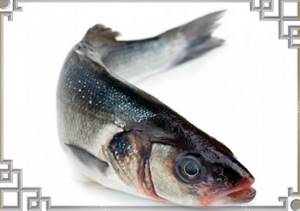
Habitat
It is difficult to describe exactly the distribution area of sea bass and say where it is found in large numbers. This fish does not stick to certain places and constantly migrates. Lavrak lives in the Atlantic Ocean, the Black and Mediterranean Seas, in coastal and artificial reservoirs of Europe and northwestern Africa. Young individuals gather in schools, while adult fish prefer solitude.
To learn more:
Pelengas: valuable fish of the mullet family
Common sea bass
Koikan likes to swim near the coast and at the foot of cliffs, sometimes swims into river beds and penetrates through them into shallow mainland zones. Lavraks are very active and constantly change seas, moving in whole families. Common sea bass walks both on the surface of the water and in the depths. Its main habitats are the eastern part of the Atlantic, the Black Sea and Mediterranean coastal zones.
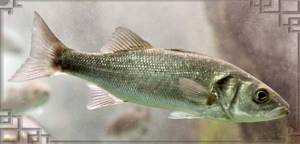
Black sea bass
The black or Chilean species, unlike the ordinary one, does not like bright sunlight and is found exclusively in deep layers, where it is dark and cold. It has taken a liking to the western side of the Atlantic and has spread along the entire American coast, especially in the oceanic waters of North Carolina.
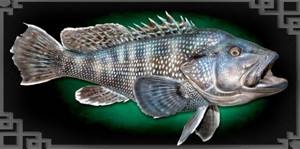
Behavior in nature and diet of the sea wolf
Despite the fact that bay laurel loves depth, it also feels normal on the surface of a reservoir. Prefers a calm environment with no or little current. This is a nocturnal fish and becomes active after dark. During the day it usually hides among algae.
Taste preferences are varied. The diet includes small fish, shrimp, crabs, shellfish, and sea worms. However, the predator's favorite delicacy is sardines. Therefore, in the summer season, the sea wolf makes long migrations to their habitats.
When going out to hunt, sea bass hides in an ambush, where it freezes in anticipation of its catch. Seeing prey, it jumps out and swallows it. Conspiracy is necessary not only to monitor the prey, but also to hide from other larger predatory fish.
The young live a gregarious lifestyle, when an individual gains about 10 kg, separates and becomes a solitary animal.
Spawning season
Sea wolves reach sexual maturity at 2-4 years. The inhabitants of the Atlantic Ocean develop more slowly, males are ready to reproduce at the age of 4-7 years, and females at 5-8 years.
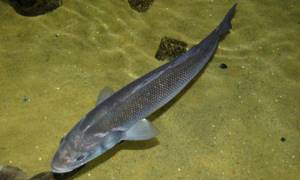
Fish spawn mainly in the cold season
Common laurel spawns in winter, although in southern countries it also spawns in spring and summer. The warm season in these regions is accompanied by heavy rainfall, which stimulates the reproduction of sea bass.
The eggs are smooth, fatty, and do not stick together. The female deposits them in burrows hidden under snags and vegetation. Usually places a shelter on the shallows. The male protects the clutch and takes care of future offspring.
After three days, the larvae develop and transform into fry. Most often, there is an equal ratio of males and females.
The nuances of human breeding
The lack of sea bass in natural reservoirs has pushed some European countries to artificially breed this species. Two technologies for keeping fish have been developed:
- Closed installations. Water tanks are located indoors near the sea. Filled with natural salt water or fresh water, artificially filled with salts and other components found in sea water. The installation includes a filtration system, an ozonizer, a pump, devices for enriching the environment with oxygen and heating. The growing cycle under such conditions is shortened as much as possible. After 2-2.5 years, an adult weighing 400-500 grams is obtained.
- Sea farm. In the open sea, nets called cages are placed. To hold them on the surface, buoys are attached, and anchors or weights are used as clamps. Each cell contains a certain type of individual with the same external and age parameters.
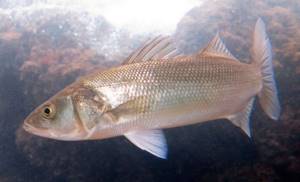
Breeding sea bass in the natural environment improves the quality of the product.
It is worth remembering that fish raised in captivity are different from their natural inhabitants:
- the body is shortened and more rounded;
- weight does not exceed 500 g;
- the fat content is higher, the culinary value is lower.
Wild representatives are considered a delicacy, but artificially grown ones are no longer considered a delicacy. Despite this, bay laurel obtained in captivity is a sought-after and expensive food product.
Description of the fish
Sea bass has an elongated body, slightly compressed on both sides. It is covered with large scales. The head has a conical shape. The fish's mouth is terminal, with a large number of villous teeth on both jaws - they are also present on the palate, tongue and vomer. Sea bass do not have combs. The fish has two dorsal fins with spiny rays. 25 vertebrae.
The body has a silvery color, the back has a blue tint, and the pelvic fins have a yellowish tint. Looking at the photo, you can notice the difference between juvenile sea bass fish and adult individuals - the former has black dots on the upper part of the body. Body length can reach 103 cm, but more often it is 50 cm.
Fishing methods for amateur fishermen
Before catching sea bass, it is important to study its lifestyle, habits, and eating habits. To get a good catch, you need to consider a few tricks:
- fish bite better in windy weather;
- daytime fishing is productive when it’s cool and cloudy outside;
- during high tide, individuals are located near the coastal zone;
- the bottom of the reservoir should be stone or sand;
- The optimal water temperature is 15 degrees.
There are two ways to catch sea wolf - fly fishing or using a spinning rod. Each method has its own characteristics, pros and cons.
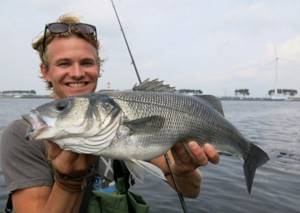
Sea bass caught on a spinning rod
Spinning fishing:
- Use artificial bait, such as silver spoons and small fish. Of the latter, they prefer imitation mackerel or eel.
- Install a spinning reel;
- The optimal fishing location is a small cliff or rock. During high tide, a large number of fish wash there;
- recommended for night hunting.
Fly fishing:
- The bait is artificial, using wobblers reminiscent of sardines or mackerel.
- The color scheme of the nozzles depends on the time of day. At night, a combination of red and black is suitable; closer to the morning, silver, light and yellow shades. During the day it is better to use red, white or blue baits.
- They use special fly fishing gear for fishing in salt waters (grade 7-8).

Fish can also be caught using fly fishing gear
Sea bass fishing
When preparing to hunt koikan, it is important to know what kind of fish it is and what behavior it exhibits. It is better to fish in mid-spring and from late summer to early winter - during these periods there is a high biting rate. Lavrak is active at sunset and at night. Sometimes you can catch it during the day if the weather is cloudy and cool.
To learn more:
Seasonal fishing for predatory navaga
A good place for a catch will be the tidal zone, where it swims for food. It is advisable to look for a sandy or rocky bottom.
You need to start fishing 3-3.5 hours before high tide. The moment the water recedes, the sea bass also swims into the depths and there is no point in continuing the hunt. Sometimes it is also found in shallow water formed after low tide.
Secrets of a successful catch:
- The sea wolf bites well in the wind. In such conditions, it swims faster and more actively to feed.
- It is important not to miss the peak of the tide when the sea bass comes close to the shore. At low tide, the likelihood of catching fish is significantly reduced.
- For night hunting it is better to use a spinning rod.
- It is necessary to catch sea bass at a water temperature of 16-14°C.
Sea wolf is caught in two ways: fly fishing or spinning.
Fly fishing
For fishing with the first method, use a 7-8th class fishing rod, designed for fishing in salt water. The coil must also meet this requirement. Suitable hook sizes are 4/0-4. Different cords are suitable, depending on the fishing location.
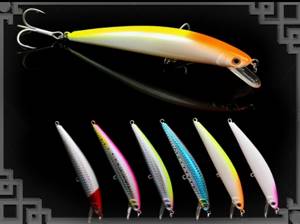
For bait in the fly fishing method, wobblers are selected that imitate fry of sardines, mackerel or mullet. Their color should depend on the time of day. Before dawn, it is advisable to lure the predator with yellow and silver decoys. In the morning you need to choose something brighter. And at night it is better to use black and red imitators.
Spinning
For such fishing, you should choose the rocky coastline. During high tide, many fish swim to such places in the hope of catching prey. You don’t even need to cast the bait far, since the sea bass comes quite close to land. A carp fishing rod of about 3.5 meters with an inertia-free reel is selected.
Silver spoons are suitable as bait for spinning fishing. They are carried out at the bottom or in mid-water. The dummies of the fry lead closer to the surface. They can be either floating or heavy, sinking. The bayfish bites well on artificial eels and mackerels.
To learn more:
Vobla - what kind of fish, description and way of life

